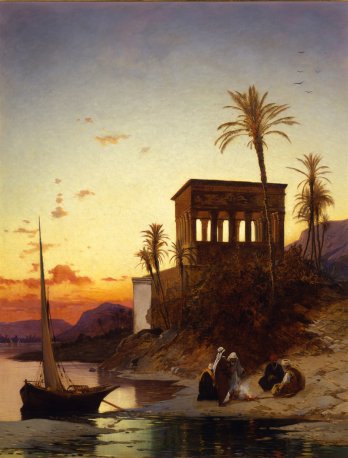Campfire by the River: Kiosk of Trajan at Philae
Overview
Campfire by the River: Kiosk of Trajan at Philae [ edit ]
Son and pupil of the influential Swiss painter, Salomon Corrodi (1810-1892), Hermann-David traveled extensively through North Africa and the Middle East. Generally avoiding the hectic markets or idealized harems popular in Orientalist art, Corrodi preferred to paint picturesque monuments at sunset, achieving the same Romantic balance of stately grandeur and mysterious calm which his father found in Alpine landscapes. The present painting is no exception: Corrodi intentionally avoids the towering pylons and crowded chapels of Philae, focusing instead on the quiet, only partially decorated Kiosk of Trajan (aka, “Pharaoh’s Bed”), attended by a small gathering of fishermen.
Trajan’s Kiosk was a popular subject for photographers and painters in the Nineteenth Century—Corrodi himself painted several variations of this scene—and it remains a beloved highlight for modern-day tourists. Juxtaposing exquisite Egyptian architecture with a pristine Nile view, this small monument distills the unique mystery of Philae, a remote island devoted entirely to the goddess Isis and her divine entourage.
The kiosk bears hieroglyphic inscriptions containing cartouches of the Roman emperor Trajan (98-117 BCE), but the structure may be considerably earlier. Based on its position and architectural style, the large open-air kiosk functioned as a bark shrine. During annual festivals at Philae, riverine boats from other temples would dock outside this structure, where local priests would remove divine statues and carry them into the temple precinct. Philae stood at the frontier between Egypt and Nubia, and nautical processions connected this center of traditional Egyptian religion to shrines and devotees further south, from the nearby temple of Dendur—currently in the Metropolitan Museum of Art—to the distant city of Meroe.
Dimensions
33 x 25.5 in
Artist or Author
Hermann-David Salomon Corrodi
Museum
Dahesh Museum
Accession Number
1995.2
Caroline Juler, Les orientalistes de l’école italienne (Les orientalistes 5; Paris: ACR Édition, 1987), p. 66
Gerhard Haeny, “A Short Architectural History of Philae,” BIFAO 85 (1985): 230; Günther Hölbl, Altägypten in Römischen Reich: der römische Pharao und seine Tempel, II: Die Tempel des römischen Nubien (Mainz: Philipp von Zabern, 2004), pp. 86-87, 90-92.
For the function of these kiosks, see generally Claude Traunecker, François Le Saout, Olivier Masson, La chapelle d’Achôris à Karnak, II (Paris: Editions ADPF, 1981).








